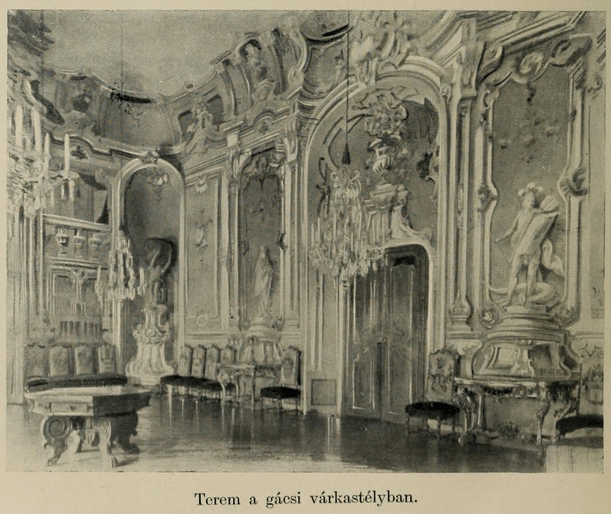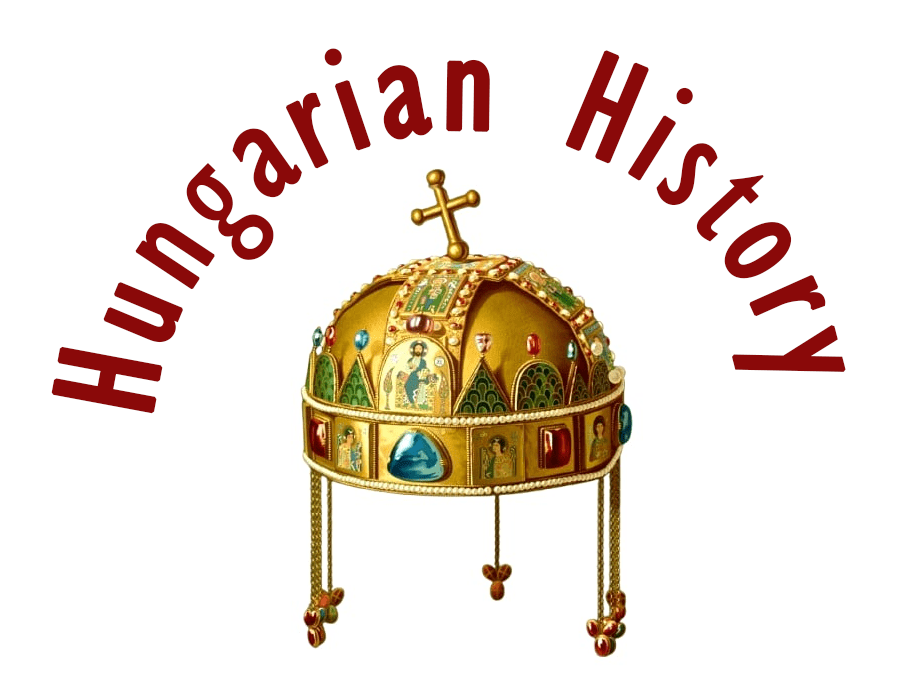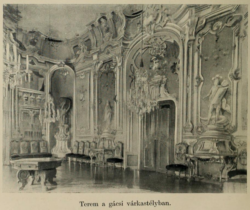
Gács (Halič) castle is in a village, it can be found in Slovakia. It is 7 km from Losonc (Lucenec) where my grandfather was born. The first mention of Gács dates back to 1299. Its former castle was built by the Losonci family in the second half of the 13th century in the Kingdom of Hungary. Location: https://tinyurl.com/vzs7yxch

The name of Gács can be found in the papal tithe list of 1332-1337. According to the 18th-century county historian Mocsáry Antal, “it took its name from the former Halitzian family, which came down from Galicia. This foreign nation was first besieged by King Kálmán, then by King István II, and finally King Géza II annexed it to Hungary and turned it into a Hungarian nation. So whether we take their settlement or their industrious diligence in the first construction of the Gács castle, it is clear that this castle took its name from the Halitzian family.”

The first Gothic castle of Gács was probably built in the 1300s. The old fortress, of which only a few stumps of walls remain, protected the road from Fülek to Zólyom. It fell into ruins during the battles against Csák Máté and was rebuilt in 1386 by the first owners of the castle, Losonczy István of the Tomaj family. In 1451 it was occupied by Jan Jiskra, who fortified its walls. However, Hunyadi János took it back, but the building fell into ruins.

The Losonczy family then rebuilt it without permission, and the Diet immediately ordered its demolition. According to some theories, however, the order of 1542 was not carried out because the lord of the castle, Losonczy István, had switched allegiance to King Ferdinand. It was Losonczy István, who in 1547 became the chief Comes of Nógrád County and in 1552, as captain of Temesvár, withstood the Turkish siege for a month before surrendering the castle to Ahmed Pasha, who took the wounded man prisoner and had him beheaded.

The heroism of Losonczy was immortalized in a long historical song by Tinódi Lantos Sebestyén: “Much good shall be given to the king, for his servant the valiant Losonczy, He let all his castles go to his daughters, He made them sons of many goods. ” It means that the king granted the daughters to inherit the properties as if they were male heirs. One of the daughters of this heroic captain was the great love of the poet Balassi Bálint, Losonczy Anna, wife of Forgách Zsigmond.

This is how the castle of Gács, together with Szécsény and Somoskő in Nógrád, became the property of Forgách Zsigmond (1565-1621), later a State Judge and a Palatine, and for centuries it was the property of this noble family. In 1612, Zsigmond, the chief Comes of Nógrád county, built his new residence on the hill of Gács, which was later defended by strong bastions and ramparts.

In the course of history, Gács has thus fulfilled the functions of a Borderland fort, a seat of the manor, and a seat of public administration. Many members of the Forgách family living here were archbishops of Nógrád County. For example, from 1621 to 1681, the manorial headquarters of the State Judge Forgách Ádám was located here. He was captain-general of Szécsény, general of Kassa (Kosice, Kaschau), and commander of Érsekújvár (Nové Zámky).

He also wrote a description of his battle fought at Érsekújvár with the Grand Vizier Köprülü in 1663. After the capture of Fülek Castle (1553) and its final destruction (1682), the noble county also held frequent assemblies in Gács. The members of the Forgách family also kept a small private army here at this time. In 1678, Prince Thököly Imre appeared with his “kuruc” (anti-Habsburg) troops under the castle, and Captain Makfalvay József passed three cannons to them.

At the beginning of Prince Rákóczi II Ferenc’s campaign, the rural nobility, including some of the officers of Pest County, sought refuge in the castle. In 1703 they successfully resisted the Kuruc army, but after negotiations, they surrendered to Rákóczi. In 1709 the Imperial troops besieged Gács.
In the mid-18th century, Count Forgách János (1724-1774) started a large-scale construction project in Gács.

In Mocsáry’s time (early 18th century) the village “boasted some fine stone buildings”. Among them, the salt house and some “beautiful and mostly two-story buildings necessary for the factory” stood out. This shows that Gács was already an important industrial, commercial, and transport center in the eighteenth century. A few manufactories were already being built under the Forgách castle, the village was already crossed by a regular postal service, and national fairs were held here several times a year. All this, of course, required a ‘well-appointed inn’, and the town was not lacking in this respect.

The old buildings still include the Baroque-Classicist salt house from the 18th century, the Baroque building of the former majolica factory from the 18th century, the Classicist building of the broad-cloth factory from the last century, etc. The Roman Catholic Baroque church was built by the Forgách family in the 18th century. Its altarpiece was painted by Kubányi Lajos from Nógrád in 1889.

Among his largest oil paintings is the one, which depicts the scene of the finding of the crucifix. Of course, the most notable building in Gács is the Manor House on the hill above the village. ‘The castle of Gács hovers regally over the valley below’, wrote Kazinczy Ferenc in 1831, who was wandering through Hungary on his travels. At the time, Mocsáry was enchanted by the castle’s location and landscape.

In his report on Nógrád County, we read the following note: “The location of this pleasant castle is very beautiful, and at the same time it is also a strong protection. On the top of a lonely long round hill, which bends from north to south, to the east the village of Gácsfalu is visible, where the village is separated from the castle by the waters of the river Tugár, one branch of which flows into the fish pond of the manor, where about half a century ago there was a warren garden.”

In 1835, during his trip to Gács, Petőfi Sándor, the great poet also visited the castle. “I visited some of its rooms, and the one that attracted my attention the most was the one with the family portraits. I could hardly part with one of the pictures. It was a lady: beautiful, young, and frenetic.”

The castle was also baroqueized, and the original building was significantly altered inside and outside. By 1762, the hexagonal Renaissance fortress had been transformed into a beautiful Baroque castle designed by the Salzburg architect Andreas Meyerhoffer. The castle was remodeled in 1896 to its present form. Damaged during the World War, it was restored between 1950 and 1960. In 1990 the building was a mental hospital and is now a hotel.
Here is a video of the castle (in Hungarian): https://www.facebook.com/share/v/1B5dc7jUH8/):

Source: Csáky Károly: Hagyományaink nyomában – A gácsi várkastély
Dear Readers, I can only make this content available through small donations or by selling my books or T-shirts:
Please, support me with a coffee here: https://www.buymeacoffee.com/duhoxoxa
You can check out my books on Amazon or Draft2Digital, they are available in hardcover, paperback, or ebook:
https://www.amazon.com/dp/198020490X or at https://books2read.com/b/boYd81

My work can also be followed and supported on Patreon: Become a Patron!http://Become a Patron!
Become a Patron! and donations can be sent by PayPal, too: https://tinyurl.com/yknsvbk7


https://hungarianottomanwars.myspreadshop.com/all
Subscribe to my newsletter here: https://tinyurl.com/4jdjbfkn
Here are a few more pictures of Gács:






























